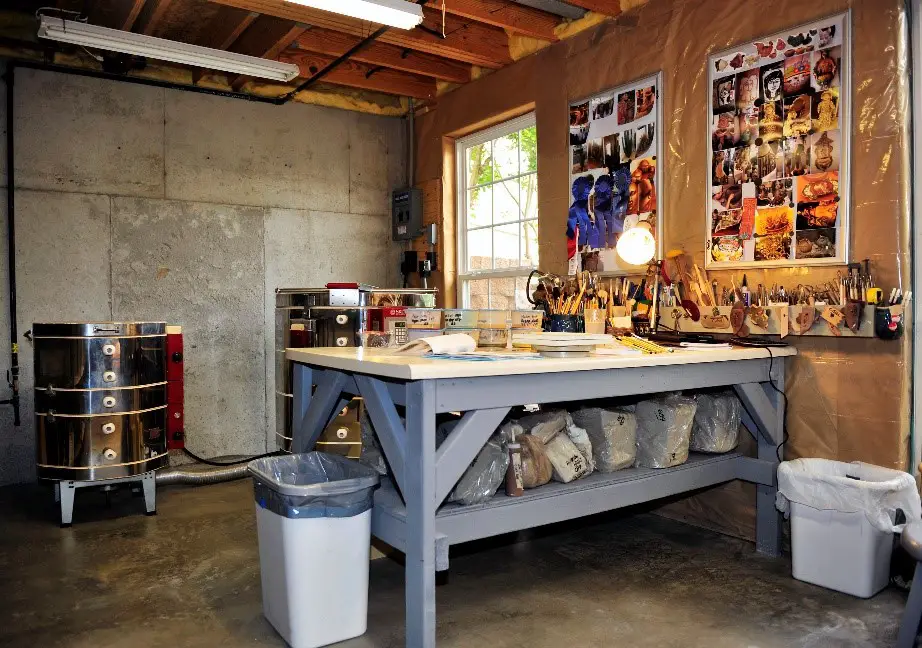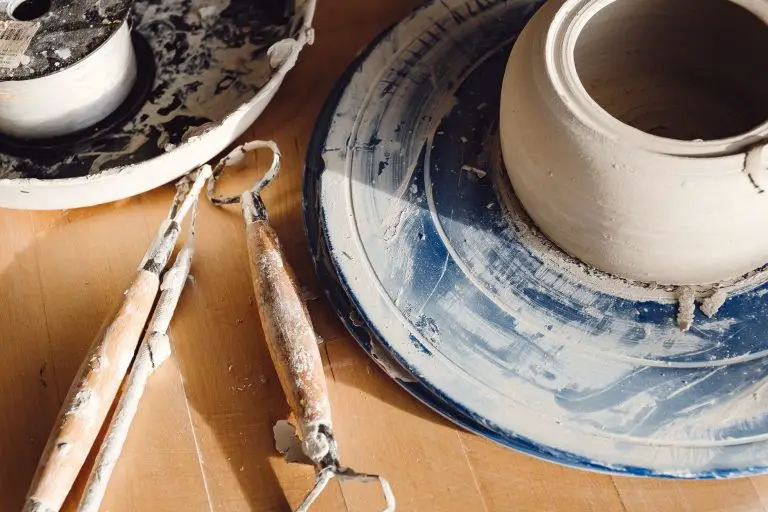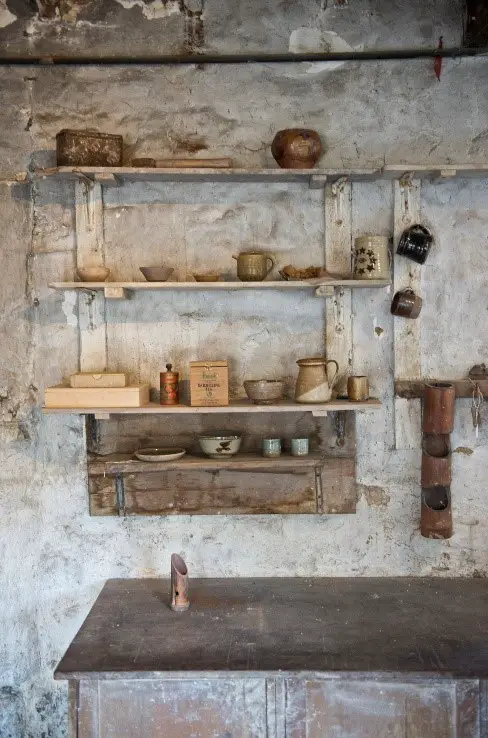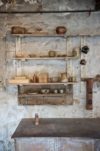If you have a pottery studio, the first thing that you may consider is setting it up, and the best ways to keep it organized. Having an organized pottery studio is quite important. With an organized studio, you’ll be able to find everything, and we’ll touch on what you will need to consider when organizing, along with a few things to take into consideration. This post will go into detail about the tips that will make the studio shine and some various aspects to keep in mind.

Why Organize
So why in the world should you organize? Why does it matter for a pottery studio to be nice and tidy? It is much bigger than you’d expect.
Organizing is probably human’s least favorite activity, and it’s where many people flaw when it comes to building not just their pottery studio itself, but life in general. However, if your pottery studio is very disorganized with stuff everywhere, and you’re unable to find anything, well guess what? It’s not going to be fun to work in it. you need to have a nice and very put-together studio to make everything right, and there are many benefits to organizing.
Some of the benefits of organizing include the following:
- A cleaner space
- A space that feels better
- You know where stuff is
- It’s a safe thing—lots of times if you have stuff on the ground, you may be liable to trip over it, and you might end up throwing pottery across the room, breaking it
- Saves you a headache
- You can have easier access to each of the functions of pottery
- It makes pottery so much more fun, and you won’t feel stressed trying to think about where in the world you have everything that you need
Lots of times, people think that a general setup works, and while it does, lots of times people are running around, trying to find the glazes and stains, while their hard work is drying. If you’re marbling, you’ll start to realize as well that if you have a disorganized space, and don’t have everything put away, it could potentially ruin your work, since you only have a few seconds window there before stuff dries. Save yourself the headache of having to run all over the place, and start to look into organizing your pottery now.
So where do we begin? Well, read on, because we will go into great detail about each of these aspects.
The Space itself
With this space, you want to create something that works for you. Ideally, you should make sure the spaces fit the criteria that you want from a pottery studio.
Some of the criteria that you might want to look into are the following:
- Is it big enough?
- Can I move around easily without tripping over stuff?
- Can it hold big pieces of machinery, including a kiln?
- How close is the nearest sink for me to get water?
- Can I put a space to house the pottery before it fires?
- Am I limited by the space in terms of personal creative boundaries
- Is there any way I can incorporate any current fixtures into this?
Some people, use their garages as their space, which is fine, so long as you make sure to follow the safety factors that are present in this. Others take the time to build their pottery studio with their work. It’s currently something that you will want to think about.
You also should check a couple of these other factors as well when you’re building the studio, including:
- Is it close to my home, possibly providing any sort of danger, or is it far enough away that I have to walk to it?
- Will I have enough ventilation? This is a huge part of it, because a poorly ventilated home is a pretty dangerous thing, and you may in up breathing in toxic fumes
When you’re looking to set up and organize your space, the best thing to do is to draw up what you want it to look like, and from there see if it will have any creativity issues, and you should adjust accordingly if so.
Any fumes you should worry about?
Then there are fumes. One thing about pottery is that you are technically working with the most dangerous of materials. There is a lot that may put you at risk, and they are the following:
- The excessive heat
- Any toxic fumes you inhale
- Dust
- Chemicals
All of these are present in different parts of a studio. There are a few organization tips that you can use, however, and they are as follows:
- Always check to make sure that you’ve got lots of air around the studio to help ventilate it so that the fumes don’t stick around
- Keep a broom and dustpan on hand so that you can sweep up the dust, and don’t let it fly around the space
- Always clean up your space when you’re done, don’t let it sit
- Make sure to cover all of the stains as best as you can
- Create a storage space for your stains and glazes so that they’re not out in the open
- Make sure that, if needed, you have a lot of space around the kiln so that the air around it can circulate
- Make sure that there is enough room for your body away from the kiln so that you don’t get burned
- Make sure that, if you’re working with toxic chemicals, you have the proper equipment, and as needed, make sure that you have the right protective gear
With all of this, you’ll definitely want to check to ensure you’ve got everything. The problem with a lot of pottery things is that it’s actually extremely toxic. For example, clay contains silica, which if that gets into your system, can warrant breathing problems. A lot of the glazes you may use are actually quite toxic until they’re fired, and the same goes for stains. Lead-based glazes especially do this, so you’ll want to be careful about this before you begin, and you’ll want to make sure your space is properly ventilated, and you have spaces to handle all of the fumes that may come from this.
If you do need to take a break from the studio due to fumes, but you have the kiln running, make sure there is always a place for you to eye the kiln just in case something happens. You should never leave the kiln unattended.
The two essentials
There are two essentials that you’ll need, and when choosing to organize your space, you should always make sure that you have them. They are:
- Electricity
- Water
These are two important things, probably the most important after the clay itself, that you’ll need in your studio. That’s because of the following:
- Water is how you shape the clay, and if the clay gets too hard, you can’t work with it
- Electricity is how you run many of your machines, especially if you have a kiln or wheel that is electric
If you don’t have these, make sure when you’re organizing and setting this up you put this together. When it comes to studios you should have a supply of water that runs somewhere, such as a sink, and with electricity, you should install sockets and such.
Now, before you buy or rent your kiln, you’ll need to look at the kiln power supply. There are many times when people won’t look into this, and it actually can make a huge difference. There are two types of that are typically in a studio, and they are:
- A single-phase amp
- A three-phase amp
Now, three-phase, in essence, means that you have alternating current, power generation, and distribution and transmission all put into there. This is something that you may see when looking at a kiln.
Those are the three-prong outlets, but a single-phase amp is often one that you have in a studio, if it’s a three-phase one, you’ll need to make sure that you get a means to increase it. This is a huge thing that many don’t realize can play a major role in this.
If you have a three-phase and yours is a single-phase, it may not work, or it could put the studio in danger, and you’ll want to figure out what you’re going to be using before you put it in the studio.
Determining equipment
When you go look at all the different types of pottery equipment, you’ll notice that there is a lot. So much in fact that it may not fit in the studio initially. You need to look at the resources, and your space as well, and you should figure out from there what you need in it.
For example, consider the following:
- If your studio is small, you may have to opt for the smaller versions of everything, and vice versa if you have a bit of room that you can afford for the pottery studio, you should consider giving it some extra room.
- How much are you willing to spend? Pottery stuff gets expensive
- If you’re not looking to spend a lot, you should not do so. Remember, you can always get it when you’re ready
- Look at what you’re going to be using. If you don’t think you’re going to need a slab roller, then guess what? Don’t buy it
- You should always look at the studio, look at your budget, and develop a floor plan to figure out what’s necessary
If you’re still really stumped at what you want to do with this, you should then start to make a checklist of the bare minimum that you need to get your studio up and running.
With all of this in mind, you’ll be able to choose for yourself just what you need to get the ball rolling on this and to help you organize your studio.
It is encouraged, however, that if you need storage cabinets for stuff, get some. Some people like to use tubs, which does work, but if you get a drawer that you’re able to put everything in, and you can open up and see all of your stains and glazes right there, it’ll make your life so much easier, and you’ll be much happier with this as well.
Do I need a wheel or a Kiln?
Well, that is a very loaded question and there isn’t a yes and no answer. The first thing you have to think about is how much space you have to spare.
If you think you have spacious room for a full wheel then read our review of the two best wheels on Amazon by clicking here for our review.
Now, on the other hand, you might not have enough room for a full wheel but luckily we have a review of a great tabletop version called Speedball Portable Artista Tabletop Pottery Wheel.
And if you looking to do big projects or complex projects in your studio and you want to fire your pottery read our review of Rapidfire Pro Kiln which is small and portable.
What about Tools and Equipment?
We have you covered and we have a great toolset to use in your newly organized studio. Read our review Spinningpots.com by clicking here to read our review of Meuxan 30PCS Pottery Tools Clay Sculpting Tool Set.
And found it on Amazon at a great price and with great reviews. Click here to read our review of it. Best Tool Set on Amazon.
What inspires you?
You want to think about your inspiration. This isn’t just having a nice studio with all the bells and whistles. It’s really not that smart to go drop all of this money on something that you may only do for a second and then waste it, or maybe you want to get serious with it, but all you do is buy beginner tools, so you have to rebuy everything.
There are a few questions that go along with this, and they are as follows:
- Are you just trying to get better, or are you looking to get super involved?
- Are you advanced and want to learn more?
- Are you serious about this, and do you want to work on a personal deep level?
- Have you moved past the average studio and want to make your stuff?
If you feel like you’re serious about it, sometimes, buying the higher-end stuff will save you money, especially when it comes to a kiln. If you’re starting and you intend to be a beginner with it for a while, and it’ll be slow-going motion, you’ll want to probably opt for the beginner stuff.
Also, look at what inspires you. perhaps you took up pottery cause you’ve wanted to learn a certain skill or technique, but you didn’t know how. If that’s the case, you should work towards that goal, and try to emulate it. If you are doing this because you feel like you’re happy with it, make it a more personalized adventure for yourself.
It’s also what you’re willing to use when you’re making pottery. You have two options most of the time, and they are:
- Hand building
- Wheel throwing
Some people like hand-building because it’s a little bit cheaper and less involved, but it also may cost a bit much if you get the really expensive options. Typically, slab rolling is good for those who want to begin with slab pottery, but they often are a bit intimidated by the designs. Slab pottery is much easier, although limited, but you should think about what the options are.
If you’re going wheel throwing, typically, it may cost a little bit more. You should make sure that you’re able to get the right kind of wheel for yourself too.
Typically, if you’re someone who’s going into hand building, you need a slab roller. Slab rollers are great because they can help roll out the slabs, and if you’re someone that finds rolling the clay a lot of work, and a bit of a waste of time. If you’re someone who is thinking about getting into throwing, consider your wheel. You’ll want to get something that fits your personal skill level and ultimately will make you happy.

If you’re worried about what you should get, ask yourself these two questions;
- Do I want to learn a niche, or just focus on pottery in general?
- Is there a type of pottery that I like a whole lot more than the other, and if so, should I focus on it?
You need to choose what works best for you, and the type of different options that you have.
What About Clay?
Did you know that clay can affect studio organization as well? lots of times, people don’t think about this, but you’ve got two options, and they are:
- Buying the clay bagged
- Making your own
If you go with making your option, you’ll need a pugmill, which is something that blends the clay and water to help create the consistency you desire. This does take a lot more work, but some seem to find a bit of satisfaction in this as well.
For many who are thinking about this, you should consider the following when building your studio:
- Clay that’s bagged is much easier to store, and you can get a container or some drawers to put the clay in
- If you make your own, you’ll have more cartons around, and possibly more materials, especially a sieve if you’re working with localized clay
- You’ll also have to keep in mind the material costs. Clay that’s bagged and made already is much more expensive, but with ones you make on your own, it’s much more expensive and requires a pugmill for you to use it
These factors are a huge part of it, and when you’re organizing, it’s best to make sure that you have your own space to work as needed when creating some fine pottery.
How to plan the space
If you’re looking to plan the space, there are a few things that you can do, and here is the ultimate set of tips to help you get your space put together:
- First, look at the space to make sure you have enough plug sockets
- Make sure you’ve got the areas for a hang building area, a workbench, a glazing area with a window nearby, a space for a wheel as needed, and a meter of space around the kiln for safety reasons, a place to dry, a sink, and a place to store clay
- If you’re working with a lot of space, you can get one of those racks for damp pieces of clay that are being worked on
- If possible, lay out the studio as much as you can before you buy everything
- Always think about what clay processes you’re using. For example, what do the throwing process requirements in terms of space, and then plan accordingly
- If possible, put your clay near the workspace area, and then set up the workbench nearby
- Create a flowchart and from there, look at how your studio will work if you do this, and adjust and change as needed to get the maximum space
- Make sure that the throwing or hand-building workspaces are right next to the drying area
- Typically, greenware is in the raw state when fired, and through any drying stage, it’s fragile so make sure the trek between the throwing or hand-building area and the dining area is minimal
- Make sure that the kiln is close by too, but obviously with the space kept in check
- Make sure that you have enough storage space as well for everything that you have, including clay scraps. It also may include dry clay and the glazes that you need
- You should consider putting the objects that need to be dried on their shelf as well, and make sure it’s got enough space that it won’t be jostled when drying
- Work to utilize the space that you currently have as your studio, and from there, if you ever want to expand on this, you totally can. Plus, if you have it in a space that you’re already using, you will be more liable to use it. some people want to use their spare bedrooms or even a porch that you can put together to make your pottery studio

For many who are looking to get more into pottery, sometimes the organization is a key part of this. If you’re looking for the best ways to organize your studio in an effective manner, then look no further. There is so much that you can do with a pottery studio, that many don’t even realize what they can do with it. But, with proper planning before your execution, and making sure everything is all set up and raring to go, you’ll be able to create the best studio that you can, and utilize this as effectively as possible.







